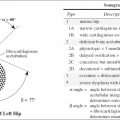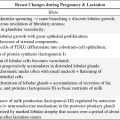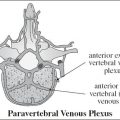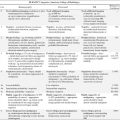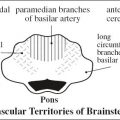pancreas divisum + bile duct carcinoma (in adult)
Location: 2nd portion of duodenum (85%);
1st / 3rd portion of duodenum (15%)
• mostly asymptomatic with incidental discovery
• neonate : persistent vomiting ← “gastric outlet” obstruction (in 10%)
• adult : nausea, vomiting (60%), abdominal pain (70%), jaundice (50%), hematemesis (10%); symptoms of peptic ulcer disease (25%) / acute pancreatitis (13%)
√ “double bubble” = dilated duodenal bulb (= smaller distal bubble) + distended stomach (= larger proximal bubble)
√ proximal duodenal dilatation
OB–US: √polyhydramnios
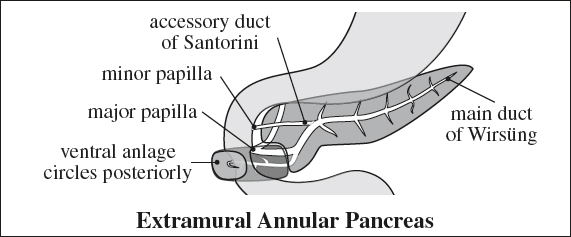
UGI:
√ eccentric narrowing with lateral notching + medial retraction of 2nd part of duodenum
√ concentric ringlike narrowing of mid-descending duodenum between major and minor papilla
√ reverse peristalsis, pyloric incompetency
CT:
√ enlargement of pancreatic head
√ pancreatic tissue encircling descending duodenum
ERCP (most specific) / MR pancreatography (MRCP):
√ normally located main duct in pancreatic body + tail
√ small aberrant duct encircles duodenum (= originates anterior to + passes posterior to duodenum) communicating with:
› main duct of Wirsüng (in 85%)
› accessory duct of Santorini
› intrapancreatic common bile duct
Cx: in adults increased incidence of
(1) Periampullary peptic ulcers
(2) Pancreatitis (15–20%): usually confined to pancreatic head and annulus
(3) Duodenal obstruction (10%)
Rx: gastrojejunostomy / duodenojejunostomy
AGENESIS OF DORSAL PANCREAS
Variation: complete (extremely rare) / partial
May be associated with: heterotaxia (abnormal situs, polysplenia), intestinal malrotation
• nonspecific abdominal pain ← ? pancreatitis
• diabetes (in many)
√ short round pancreatic head adjacent to duodenum
√ absence of pancreatic neck, body, tail, duct of Santorini, minor duodenal papilla
DDx: pancreatic carcinoma with upstream pancreatic atrophy
ASCARIASIS
Organism: nematode (roundworm) Ascaris lumbricoides, 15–50 cm long + 3–6 mm thick adult worm; life span of 1 year
◊ 3rd most common helminthic infection (after hookworm + trichuriasis)
Endemic: in tropical + subtropical areas
(a) in parts of Africa (along Gulf Coast, Nigeria), Southeast Asia, China, South America: 90%
(b) in USA: 12% in blacks, 1% in whites; endemic in Appalachian range + Ozark Mountains
Prevalence: most common cosmopolitan parasitic infection (25% of world population infected); 1 billion humans harbor the roundworm [ cosmos , Greek = world; polites , Greek = citizen]
Infection: fecal-oral route
Cycle:
contaminated water / soil / vegetable → ingestion of eggs; eggs hatch (= release larvae) in duodenum → larvae penetrate intestinal wall + migrate into mesenteric lymphatics and venules;→ carried to lungs via right heart + pulmonary artery; → mature in pulmonary capillary bed to 2–3 mm length → burrow into alveoli → ascend in bronchial tree; through swallowing again reach small intestine → mature in jejunum into adult worms within 2.5 months (worms may migrate and settle in biliary + pancreatic ducts) → production of 200,000 eggs daily leave body by fecal route
Age: children 1–10 years of age
• pulmonary + intestinal symptoms:
• fever, cough, expectoration (hematemesis / pneumonitis)
• appendicitis
• biliary symptoms:
• jaundice (if bile ducts infested); abnormal liver function tests
• biliary colic ← Ascaris secretions induce spasm of sphincter of Oddi
• eosinophilia:
• hypereosinophilia only present during acute stage of larval migration; Löffler syndrome = pulmonary eosinophilia
Pancreatic / biliary manifestations occur when the adult worm migrates from small bowel into the main pancreatic duct / biliary tree. Related complications are biliary colic, gallstone formation, cholecystitis, liver abscess, and pancreatitis.
Location: jejunum > ileum (99%), duodenum, stomach, CBD, pancreatic duct
Barium study:
√ 15–35 cm long elongated tubular filling defects
√ whirled appearance, occasionally in coiled clusters (“bolus of worms”)
√ ± barium-opacification of enteric canal within nematode
CT:
√ worms are hyperattenuating relative to bile
MR:
√ worms exhibit low signal intensity on T2WI
√ fluid-filled GI tract of worms hyperintense on T2WI
CXR:
√ migratory patchy alveolar infiltrates that characteristically clear within 10 days
√ lobar consolidation + alveolar hemorrhage
| Cx: | (1) Intestinal obstruction ← massive infestation |
(2) Bowel perforation | |
(3) Intermittent biliary obstruction with acute cholangitis, cholecystitis, pancreatitis | |
(4) Recurrent pyogenic cholangitis | |
(5) Liver abscess (rare) | |
(6) Granulomatous stricture of extrahepatic bile ducts (rare) |
Dx: fecal examination (eggs in stool), larvae in sputum
Rx: mebendazole
Ascaris-induced Pancreatitis
= occasional migration of worm through ampulla of Vater into pancreaticobiliary tree via abnormally open ampullary orifice ← preexisting biliary tract disease / endoscopic sphincterotomy
◊ Most common parasitic cause of pancreatitis!
Mean age: 35–42 years; M÷F = 1÷3
US:
√ biliary / pancreatic ductal dilatation
√ pancreatic + peripancreatic inflammation
√ echogenic tubular structure without acoustic shadowing within bile / pancreatic duct with 2–4-mm wide central sonolucent line (= worm’s digestive tract)
√ worm may slowly move at real-time imaging
Cx: biliary colic, cholangitis, acute cholecystitis, hepatic abscess, acute pancreatitis, septicemia
AUTOSOMAL DOMINANT POLYCYSTIC DISEASE
= POLYCYSTIC LIVER DISEASE
= part of spectrum of fibropolycystic liver disease
Etiology: biliary ductal plate malformation at the level of the small intrahepatic bile ducts with progressive dilation of the abnormal noncommunicating bile ducts of biliary hamartomas
M÷F = 1÷2
Associated with: polycystic kidney disease (in 50%)
• upper abdominal pain + distension from hepatomegaly
√ enlarged diffusely cystic liver: cysts of 1 mm – 12 cm in diameter
√ calcifications of cyst wall ← hemorrhage / infection
√ ± diffuse dilatation of intra- and extrahepatic bile ducts
Cx: infection, compression, bleeding, rupture of cysts
BANTI SYNDROME
= NONCIRRHOTIC IDIOPATHIC PORTAL HYPERTENSION = NONCIRRHOTIC PORTAL FIBROSIS = HEPATOPORTAL SCLEROSIS
= syndrome characterized by
(1) Splenomegaly
(2) Hypersplenism
(3) Portal hypertension
Etiology: increased portal vascular resistance possibly ← portal fibrosis + obliterative venopathy of intrahepatic portal branches
Histo: slight portal fibrosis, dilatation of sinusoids, intimal thickening with eccentric sclerosis of peripheral portal vein walls
Age: middle-aged women; rare in America + Europe; common in India + Japan
• elevated portal vein pressure (without cirrhosis, parasites, venous occlusion)
• normal liver function tests, cytopenia (← hypersplenism)
• normal / slightly elevated hepatic venous wedge pressure
√ esophageal varices
√ patent hepatic veins
√ patent extrahepatic portal vein + multiple collaterals
Prognosis: 90% 5-year survival; 55% 30-year survival
BILE LEAK
Posttraumatic bile leaks / biliary tract injuries related to recent surgery are easily overlooked due to
(a) nonspecific imaging findings, especially in the setting of multiorgan injury
(b) even less specific clinical findings
(c) difficulties to discern from other postoperative fluid collections.
Cause:
1. Post orthotopic liver transplantation
2. Pancreaticoduodenectomy
3. Hepatic or biliary surgery
4. Cholecystectomy (2%): laparoscopic > open
5. Radiofrequency ablation, percutaneous biliary drainage
6. Transcatheter arterial chemoembolization
Prevalence: 7% after laparoscopic cholecystectomy
Time of onset: during 1st postoperative week
• asymptomatic subclinical bile leak (7%)
• abdominal pain, fever, nausea, vomiting
Location: cystic duct stump / ducts of Luschka (= subvesical / accessory biliary ducts)
Cholescintigraphy:
√ DIAGNOSTIC but with poor anatomic definition and spatial resolution necessitating a secondary diagnostic evaluation (especially ERCP)
MRCP with hepatobiliary contrast medium:
Agents: gadoxetate disodium (Eovist®) with 50% liver excretion 20 minutes after administration; gadobenate dimeglumine (MultiHance®) with 5% liver excretion 60–120 minutes after administration
√ dynamic biliary imaging during hepatobiliary phase with improved characterization of biliary anatomy
√ depicts peripheral sites of leakage that may not be filled with retrograde injection
| Cx: | (1) Biloma= encapsulated extrabiliary bile collection |
(2) Bile peritonitis (days to weeks after initial trauma) |
Prognosis: high morbidity + mortality rates if undiagnosed
Rx: endoscopic / surgical management
BILIARY CYSTADENOCARCINOMA
= BILE DUCT CYSTADENOCARCINOMA
= rare malignant multilocular cystic tumor originating from biliary cystadenoma
| Histo: | (a) with ovarian stroma (good prognosis), in females only |
(b) without ovarian stroma (poor prognosis) |
• hemorrhagic internal fluid
√ nodularity with septations are suggestive of malignancy
√ coarse calcifications
DDx: NO image differentiation from biliary cystadenoma
BILIARY CYSTADENOMA
= BILE DUCT CYSTADENOMA
= very rare benign multilocular cystic tumor originating in bile ducts as premalignant form of biliary cystadenocarcinoma; probably deriving from ectopic nests of primitive biliary tissue
Frequency: 4.6% of all intrahepatic cysts of bile duct origin
Age: > 30 years (82%), peak incidence in 5th decade; M÷F = 1÷4; predominantly in Caucasians
Path: multilocular cystic tumor containing proteinaceous fluid with well-defined thick capsule
Histo: single layer of cuboidal / tall columnar mucin-secreting biliary-type epithelium with papillary projections, subepithelial stroma resembling that of the ovary
◊ Similar to mucinous cystic tumors of pancreas + ovary
Location: intrahepatic÷extrahepatic bile ducts = 85÷15; right lobe (48%); left lobe (20–35%); both lobes (15–30%); gallbladder (rare)
• chronic abdominal pain
• dyspepsia, anorexia, nausea + vomiting, jaundice
• abdominal swelling with palpable mass (90%)
Size: 1.5–35 cm (reportedly up to 11 liters of liquid content)
√ well-defined cystic mass containing clear / cloudy, serous / mucinous / gelatinous, purulent / hemorrhagic / bilious fluid with hemosiderin / cholesterol / necrosis
√ thick fibrous capsule
√ papillary excrescences + mural nodules
√ septations between cysts
US:
√ ovoid multiloculated anechoic mass with highly echogenic septations / papillary growths
√ may contain fluid-fluid levels
CT:
√ multiloculated mass of near water density
√ contrast enhancement in wall + internal septa
MR:
√ locules with variable SI on T1WI + T2WI depending on their protein content
Angio:
√ avascular mass with small clusters of peripheral abnormal vessels
√ stretching + displacement of vessels
√ thin subtle blush of neovascularity in septa + wall
| Cx: | (1) Malignant transformation into cystadenocarcinoma (indicated by invasion of capsule) |
(2) Rupture into peritoneum / retroperitoneum |
Rx: surgical resection (recurrence common)
DDx: biliary cystadenocarcinoma, liver abscess, echinococcal cyst, cystic mesenchymal hamartoma (children + young adults), undifferentiated sarcoma (children + young adults), necrotic hepatic metastasis, cystic primary hepatocellular carcinoma
BILIARY-ENTERIC FISTULA
Frequency: 5% at cholecystectomy; 0.5% at autopsy
Etiology: cholelithiasis (90%), acute / chronic cholecystitis, biliary tract carcinoma, regional invasive neoplasm, diverticulitis, inflammatory bowel disease, peptic ulcer disease, echinococcal cyst, trauma, congenital communication
Communication with:
duodenum (70%), colon (26%), stomach (4%), jejunum, ileum, hepatic artery, portal vein (caused death of Ignatius de Loyola), bronchial tree, pericardium, renal pelvis, ureter, urinary bladder, vagina, ovary
A. CHOLECYSTODUODENAL FISTULA (51–80%)
1. Perforated gallstone (90%):
associated with gallstone ileus in 20%
2. Perforated duodenal ulcer (10%)
3. Surgical anastomosis
4. Gallbladder carcinoma
B. CHOLECYSTOCOLIC FISTULA (13–21%)
C. CHOLEDOCHODUODENAL FISTULA (13–19%)
due to perforated duodenal ulcer disease
D. MULTIPLE FISTULAE (7%)
√ pneumobilia = branching tubular radiolucencies, more prominent centrally within the liver
√ barium filling of biliary tree
√ shrunken gallbladder mimicking pseudodiverticulum of duodenal bulb
√ multiple hyperechoic foci with dirty shadowing
DDx: patulous sphincter of Oddi, ascending cholangitis, surgery (choledochoduodenostomy, cholecystojejunostomy, sphincterotomy)
BUDD-CHIARI SYNDROME
= syndrome of global / segmental hepatic venous outflow obstruction at level of hepatic veins / IVC
Cause:
A. IDIOPATHIC (66%)
B. THROMBOSIS
(a) myeloproliferative disorder:
polycythemia rubra vera (⅓), essential thrombocytosis
(b) hypercoagulable state:
mnemonic: 6 P’s
Paroxysmal nocturnal hemoglobulinuria (12%)
Platelets (thrombocytosis)
Pill (birth control pills)
Pregnancy + Postpartum state
Polycythemia rubra vera
Protein C deficiency
also: sickle cell disease
(c) injury to vessel wall:
phlebitis, trauma, hepatic radiation injury, chemotherapeutic + immunosuppressive drugs in patient with bone marrow transplant, venoocclusive disease from pyrrolizidine alkaloids (Senecio) found in medicinal bush teas in Jamaica
C. NONTHROMBOTIC OBSTRUCTION
(a) compression or invasion of IVC / hepatic veins:
› benign: cirrhosis, hematoma, abscess
› malignant: renal cell carcinoma, adrenal carcinoma, hepatoma, cholangiocarcinoma, metastasis, primary leiomyosarcoma of IVC, Hodgkin disease
(b) membranous obstruction of suprahepatic IVC
= IVC diaphragm (believed to be a congenital web / acquired lesion from long-standing IVC thrombosis); common in Oriental + Indian population (South Africa, India, Japan, Korea, Israel); very rare in Western countries
(c) right atrial tumor: atrial myxoma
(d) constrictive pericarditis
(e) right heart failure
D. SYSTEMIC INFLAMMATION / INFECTION
1. Inflammatory bowel disease
2. Behçet syndrome
Pathophysiology:
hepatic venous thrombosis → elevation of sinusoidal pressure → diminished / reversed portal venous flow → centrilobular congestion → necrosis + atrophy
(a) acute form (= no time for development of collateral veins) → rapid development of hepatic necrosis
(b) subacute / chronic form (venous thrombosis incomplete) → peripheral atrophy + preservation of central region with caudate lobe hypertrophy (drained by accessory veins)
In 25% associated with: portal vein thrombosis
Age: all ages; M < F
• right upper quadrant pain, lower-extremity edema
• shortness of breath ← decreased cardiac return
• nonspecific elevated transaminases, jaundice
Location:
| Type I | : | occlusion of IVC ± hepatic veins |
| Type II | : | occlusion of major hepatic veins ± IVC |
| Type III | : | occlusion of small centrilobar venules |
√ gallbladder wall thickening > 6 mm
√ portal vein diameter > 12 mm (in adults), > 8 mm (in children)
MR:
√ reduction in caliber / complete absence of hepatic veins
√ “comma” sign = multiple comma-shaped intrahepatic flow voids ← intrahepatic collaterals
√ hyperintense thrombi
Doppler US (85–100% sensitive, 85% specific):
√ one / more major hepatic veins reduced in size to < 3 mm / filled with thrombus / not visualized
√ stenoses of hepatic veins
√ communicating intrahepatic venous collaterals
√ decreased / absent / reversed blood flow in hepatic veins
√ flat flow / loss of cardiac modulation in hepatic veins
√ demodulated portal venous flow = disappearance of portal vein velocity variations with breathing
√ slow flow of < 11 cm/sec / hepatofugal flow in portal vein
√ portal vein congestion index > 0.1 [cm • sec] (= ratio between cross-sectional area [cm2] and blood flow velocity [cm/sec])
√ portal vein thrombosis (20%)
√ compression of IVC by enlarged liver / caudate lobe
√ sluggish / reversed / absent blood flow within IVC
√ hepatic artery resistive index > 0.75
NUC (99mTc-sulfur colloid):
√ central region of normal activity (= hot caudate lobe ← venous drainage of hypertrophied caudate lobe into IVC by separate vein) surrounded by greatly diminished activity
√ colloid shift to spleen + bone marrow
√ wedge-shaped focal peripheral defects
Angio (inferior venocavography, hepatic venography):
√ absence of main hepatic veins
√ spider web pattern of collateral + recanalized veins
√ high-pressure gradient between infra- and suprahepatic portion of IVC ← enlarged liver
√ stretching + draping of intrahepatic arteries with hepatomegaly
√ inhomogeneous prolonged intense hepatogram with fine mottling
√ large lakes of sinusoidal contrast accumulation
Portography:
√ central hepatic enhancement (normal hepatopetal flow)
√ reversed portal flow in liver periphery (supplied only by hepatic artery)
√ bidirectional / hepatofugal main portal vein flow
Dx: liver biopsy
Rx: control of ascites with diuretics + sodium restriction; anticoagulation, thrombolytic therapy, surgery / balloon dilatation (depending on etiology); transjugular portosystemic shunt (in preparation for) orthotopic liver transplantation (for advanced cases)
Acute Budd-Chiari Syndrome (⅓)
◊ Caudate lobe has not had time to hypertrophy!
• TRIAD:
• rapid onset of abdominal pain (liver congestion)
• insidious onset of intractable ascites
• hepatomegaly without derangement of liver function
• jaundice
√ enlarged morphologically normal liver
√ splenomegaly
√ ascites (97%)
NECT:
√ diffusely hypoattenuating liver
√ IVC + hepatic veins:
√ narrowed lumina (without thrombus)
√ hyperattenuating lumina containing thrombus (in 18–53%)
√ enlarged inferior right hepatic vein (18%)
CECT:
√ normal early enhancement of caudate lobe and central portion around IVC + decreased enhancement of peripheral liver (← portal and sinusoidal stasis) during arterial phase
√ “flip-flop” pattern during portal venous phase:
√ decreased attenuation (washout) of enhancing central areas
√ increasing patchy inhomogeneous enhancement in liver periphery ← contrast inflow from capsular veins
MR:
√ peripheral liver parenchyma of moderately low SI on T1WI + moderately high SI on T2WI compared with central portion
√ diminished + mottled peripheral enhancement
Subacute Budd-Chiari Syndrome
• portal hypertension, varying degrees of liver decompensation
√ diffuse peripheral hypoattenuation ← hepatocellular necrosis + steatosis
Chronic Budd-Chiari Syndrome (²/³)
• insidious onset of jaundice, intractable ascites
• portal hypertension, variceal bleeding
• renal impairment (in 50%)
√ dysmorphic liver:
√ nonsegmental / lobar atrophy of affected liver (← extensive fibrosis) with diminished attenuation before + after contrast administration
√ compensatory hypertrophy of caudate lobe (88%) + central parenchymal segments of right lobe + medial segment of left lobe:
√ width of caudate ÷ right lobe ≥ 0.55 (DDx: cirrhosis)
√ visualization of collateral pathways
(a) portosystemic: paraumbilical vein
(b) bypassing IVC: azygos, hemiazygos
(c) intrahepatic collateral veins (almost DIAGNOSTIC): right / middle hepatic vein → inferior right hepatic vein; hepatic vein → portal vein
√ development of 1–4 cm regenerative nodules (in areas of adequate blood supply)
√ ascites
CECT:
√ invisible IVC ± hepatic veins ← collapse / diminished flow rate:
√ nonvisualization of hepatic veins (75%) / vein diameter < 3 mm (measured 2 cm from IVC)
√ ± narrowing / obstruction of intrahepatic IVC
√ progressive heterogeneous patchy enhancement radiating outward from major portal vessels
√ “reticulated mosaic” enhancement = diffuse patchy lobular enhancement separated by irregular linear areas of low density in central area
√ delayed homogeneous enhancement of entire liver after several minutes
√ reversed portal venous blood flow ← increased postsinusoidal pressure produced by hepatic venous obstruction / rarely infarcts
Color Doppler:
√ PATHOGNOMONIC “bicolored” hepatic veins ← intrahepatic collateral pathways
MR:
√ absence of flow within hepatic veins
√ minimal differences in SI between central and peripheral portions of liver
√ intrahepatic collateral vessels
CANDIDIASIS OF LIVER
= almost exclusively seen in immunocompromised patients (acute leukemia, chronic granulomatous disease of childhood, renal transplant, chemotherapy for myeloproliferative disorders)
Prevalence: at time of autopsy in 50–70% of acute leukemia, in 50% of lymphoma patients
◊ Most common systemic fungal infection in immunocompromised patients!
• abdominal pain, elevated alkaline phosphatase
• persistent fever in neutropenic patient whose leukocyte count is returning to normal
√ hepatomegaly
√ “target” / “bull’s-eye” sign = multiple small hypoechoic / hypoattenuating masses with centers of increased echogenicity / attenuation distributed throughout liver
◊ Bull’s-eye lesion becomes visible only when neutropenia resolves!
√ hyperintense lesions on T2WI
NUC:
√ uniform uptake / focal photopenic areas
√ diminished 67Ga uptake
Dx: biopsy evidence of yeast / pseudohyphae in central necrotic portion of lesion
DDx: metastases, lymphoma, leukemia, sarcoidosis, septic emboli, other infections (MAI, CMV), Kaposi sarcoma
CAROLI DISEASE
[Jacques Caroli (1902–1979), surgeon in Paris, France]
= COMMUNICATING CAVERNOUS ECTASIA OF INTRAHEPATIC BILE DUCTS
◊ Original classification as Type V choledochal cyst (Todani classification) is NO longer accepted!
= rare congenital autosomal recessive disorder characterized by multifocal segmental saccular cystic dilatation of large intrahepatic bile ducts
| Etiology: | (a) ductal plate malformation |
(b) ? perinatal hepatic artery occlusion | |
(c) ? hypoplasia / aplasia of fibromuscular wall components |
Path: communication with biliary tree
Age: childhood + 2nd–3rd decade, occasionally in infancy; M÷F = 1÷1
Associated with: benign renal tubular ectasia, medullary sponge kidney (in 80%), infantile polycystic kidney disease, choledochal cyst (rare), congenital hepatic fibrosis, cholangiocarcinoma
• recurrent cramplike right upper quadrant pain
• bouts of fever ← cholangitis ← bile stasis
• transient jaundice ← bile stasis ← blocking stone / sludge
• cirrhosis / portal hypertension (very rare)
Location: diffuse / segmental or lobar
Types:
(1) pure form (type 1): attacks of cholangitis + intraductal stone formation
(2) complex form (type 2) – more common: associated with hepatic fibrosis / other ductal plate malformations
√ multiple small localized / diffusely scattered cysts converging toward porta hepatis communicating with bile ducts
√ beaded ducts with alternating dilated and strictured segments
√ sludge / pus / calculi in dilated ducts
CT / US/ MR:
√ “central dot” sign = enhancing fibrovascular bundle of portal vein radicles completely surrounded by cystically altered dilated intrahepatic bile ducts (IBD)
Cholangiography and MRCP (DIAGNOSTIC):
√ segmental saccular > fusiform beaded dilatation of intrahepatic bile ducts extending to periphery of liver up to 5 cm in diameter
√ ± filling defects ← intraductal calculi
√ bridge formation across dilated lumina
√ intraluminal bulbar protrusions
√ frequent ectasia of extrahepatic ducts + CBD
Dx: ERCP, direct cholangiography, MRCP
| Cx: | (1) Bile stasis → sludge + recurrent cholangitis |
(2) Biliary calculi (predominantly bilirubin) | |
(3) Liver abscess | |
(4) Septicemia | |
(5) Increased risk of cholangiocarcinoma (7%) | |
| DDx: | (1) Primary sclerosing cholangitis (multiple irregular strictures of intra- and extrahepatic bile ducts, pseudotumoral enlargement of caudate lobe, lobulated liver contour) |
(2) Recurrent pyogenic cholangitis (nonsaccular dilatation of central intra- and extrahepatic bile ducts, bile ducts tapered toward periphery) | |
(3) Autosomal dominant polycystic liver disease (no communication with bile ducts) | |
(4) Biliary hamartomas (no communication with bile ducts) | |
(5) Microabscesses | |
(6) Biliary papillomatosis |
Caroli Syndrome
= both features of Caroli disease and congenital hepatic fibrosis
= arrest of bile duct remodeling during embryogenesis + during later development of more peripheral biliary ramifications
• hematemesis ← ruptured esophageal varices ← portal hypertension
CHOLANGIOCARCINOMA
= primary malignancy arising from cholangiocyte of biliary tract
Frequency: 0.5–1.0% of all cancers;
10% of hepatic primary malignancies
◊ 2nd most common primary hepatobiliary cancer after HCC!
Anatomic classification:
A. INTRAHEPATIC (PERIPHERAL)
peripheral / distal to 2nd-order branches 8–13%
B. PERIHILAR (CENTRAL) = Klatskin tumor
at bifurcation / 1st-order branches
confluence of hepatic ducts 10–26%
C. EXTRAHEPATIC
common hepatic duct 14–37%
proximal CBD 15–30%
distal CBD 30–50%
cystic duct 6%
D. GALLBLADDER
Path (Japanese Liver Cancer Study Group):
(a) mass-forming (= nodular / exophytic) type:
commonly in peripheral cholangiocarcinoma
• homogeneous sclerotic mass typically without hemorrhage / necrosis
• central portion with variable degree of fibrosis + coagulative necrosis with scanty tumor cells
(b) periductal infiltrating / diffuse type:
commonly in hilar + extrahepatic cholangiocarcinoma
• elongated spiculated / branching growth along dilated / narrowed bile duct
(c) intraductal tubular polypoid / papillary type:
• infrequent slow growing tumor with relatively favorable prognosis
• frequently associated with marked mucin production
(d) mixed = combination of mass-forming + periductal
Histo: well / moderately / poorly differentiated ductal adenocarcinoma (most common) / papillary / mucinous / signet-ring cell / mucoepidermoid / adenosquamous adenocarcinoma with abundant fibrous stroma
Unusual manifestation:
1. Mucin-hypersecreting cholangiocarcinoma
√ severe diffuse dilatation of intra- and extrahepatic bile ducts proximal + distal to tumor
2. Squamous cell carcinoma
= metaplastic transformation of adenocarcinoma
Genetics: mutation in p53 tumor suppressor gene + k-ras gene
Peak prevalence: 7th decade; M > F
Predisposed: conditions causing chronic biliary inflammation
(1) Inflammatory bowel disease (10 x increased risk); incidence of 0.4–1.4% in ulcerative colitis; latent period of 15 years; tumors usually multicentric + predominantly in extrahepatic sites; GB involved in 15% (simultaneous presence of gallstones is rare)
(2) Biliary lithiasis: cholecystolithiasis (20–50%), hepatolithiasis (5–10%)
(3) Primary sclerosing cholangitis (10–15%)
(4) Infection with liver flukes: Opisthorchis viverrini and Clonorchis sinensis infestation (Far East)
◊ Most common cause worldwide!
(5) Recurrent pyogenic cholangitis = hepatolithiasis
(6) Viral infection: HIV, hepatitis B virus, hepatitis C virus, Epstein-Barr virus
(7) Congenital biliary cystic disease: choledochal cyst / congenital hepatic cyst / congenital biliary atresia
(8) Anomalous pancreaticobiliary junction
(9) Ductal plate malformation:
› Biliary hamartoma
› Autosomal dominant polycystic disease
› Congenital hepatic fibrosis
› Caroli disease ← chronic biliary stasis
(10) Papillomatosis of bile ducts
(11) Choledochoenteric anastomosis
(12) History of other malignancy (10%)
(13) Toxins: thorotrast exposure, polyvinyl chloride
(14) Heavy alcohol consumption
(15) Alpha−1 antitrypsin deficiency
(16) Familial polyposis
MR:
√ moderate peripheral enhancement followed by progressive centripetal enhancement
√ single / multifocal biliary strictures
√ focal / diffuse ductal thickening ± contrast enhancement
√ intraductal polypoid growth
Prognosis: median survival of 7 months, 0–10% 5-year survival
Extrahepatic Cholangiocarcinoma
= BILE DUCT CARCINOMA
Age peak: 6th–7th decade; M÷F = 3÷2
Incidence: 1÷100,000; < 0.5% of autopsies; 90% of all cholangiocarcinomas; more frequent in Far East
Histo: well-differentiated sclerosing adenocarcinoma (²/³), anaplastic carcinoma (11%), cystadenocarcinoma, adenoacanthoma, malignant adenoma, squamous cell carcinoma, epidermoid carcinoma, leiomyosarcoma
• gradual onset of fluctuating painless jaundice
• cholangitis (10%), weight loss, fatigability
• intermittent epigastric pain, enlarged tender liver
• elevated bilirubin + alkaline phosphatase
Growth pattern:
(1) Infiltrating / sclerosing type (94%)
√ ductal wall thickening + sudden luminal obliteration
(2) Papillary / tubular polypoid type (5–6%)
√ intraductal polypoid mass with irregular margin ± diffuse marked duct ectasia (mucin production)
| Spread: | (a) lymphatic spread: cystic + CBD nodes (> 32%), celiac nodes (> 16%), peripancreatic nodes, superior mesenteric nodes |
(b) infiltration of liver (23%) | |
(c) peritoneal seeding (9%) | |
(d) hematogenous (extremely rare): liver, peritoneum, lung |
UGI:
√ infiltration / indentation of stomach / duodenum
Cholangiography (PTC or ERC best modality to depict bile duct neoplasm):
√ prestenotic diffuse / focal biliary dilatation (100%)
√ progression of ductal stricture (100%)
√ frequently long / rarely short concentric focal stricture with irregular margins (in infiltrating type):
√ nipple / rattail termination
√ exophytic intraductal tumor mass (46%), 2–5 mm in diameter
US / CT:
√ mural thickening / small encircling mass of bile duct at point of obstruction (in 21% visible on US, in 40% visible on CT):
√ focal or diffuse stricture / complete obstruction of bile ducts
√ dilatation of intrahepatic ducts without extrahepatic duct dilatation
√ infiltrating tumor visible in 22% on CT as highly attenuating lesion, in 13% on US
√ exophytic tumor: visible on CT as hypoattenuating mass in 100%, in 29% on US
√ polypoid intraluminal tumor: visible on US as isoechoic mass within surrounding bile in 100%, in 25% on CT
√ regional lymph node enlargement
CECT:
√ hyperattenuating lesion at delayed imaging ← delayed accumulation + washout of fibrous center
MR:
√ hypointense relative to liver parenchyma on T1WI
√ hyperintense relative to liver parenchyma on T2WI
√ more conspicuous on fat-suppressed MR
Angiography:
√ hypervascular tumor with neovascularity (50%)
√ arterioarterial collaterals along the course of bile ducts associated with arterial obstruction
√ poor / absent tumor stain
√ displacement / encasement / occlusion of hepatic artery + portal vein
| Cx: | (1) Obstruction leading to biliary cirrhosis |
(2) Hepatomegaly | |
(3) Intrahepatic (subdiaphragmatic, perihepatic) abscess → septicemia | |
(4) Biliary peritonitis | |
(5) Portal vein invasion |
Dx: endoscopic brush biopsy (30–85% sensitive)
Prognosis: median survival of 5 months; 1.6% 5-year survival; 39% 5-year survival for carcinoma of papilla of Vater
DDx: periportal lymphangitic metastasis (no ductal dilatation, diffuse involvement of both sides of liver); sclerosing cholangitis, AIDS cholangitis, benign stricture, chronic pancreatitis, edematous papilla, idiopathic inflammation of CBD
Intrahepatic Cholangiocarcinoma
= CHOLANGIOCELLULAR CARCINOMA
Frequency: 2nd most common primary hepatic tumor after hepatoma; ⅓ of all malignancies originating in the liver; 8–13% of all cholangiocarcinomas
Histo: adenocarcinoma arising from the epithelium of a small intrahepatic bile duct with prominent desmoplastic reaction (fibrosis); ± mucin and calcifications
Average age: 50–60 years; M > F
• abdominal pain (47%); painless jaundice (12%)
• palpable mass (18%), weight loss (18%)
| Spread: | (a) local extension along duct |
(b) local infiltration of liver substance | |
(c) metastatic spread to regional lymph nodes (in 15%) |
◊ Biliary + vascular obstruction is typical!
√ ill-defined mass of 5–20 cm in diameter
√ satellite nodules in 65%
√ punctate / chunky calcifications in 18%
√ calculi in biliary tree
√ liver atrophy is suggestive although not specific
√ fibrotic pseudocapsule + secondary capsular retraction
US:
√ dilated biliary tree
√ predominantly solitary homo- / heterogeneous mass
√ hyperechoic (75%) mass for tumors > 3 cm
√ iso- / hypoechoic (14%) mass for tumor < 3 cm
√ mural thickening
√ peripheral hypoechoic tumor rim (35%) of compressed liver parenchyma
NECT:
√ single large predominantly homogeneous round / oval hypo- to isoattenuating dense mass with irregular margin
√ capsular retraction
√ stippled / punctate hyperattenuating foci (= hepatolithiasis)
√ dilatation of biliary tree peripheral to tumor
CECT:
√ hypoattenuating mass during arterial + portal venous phase
√ marked homogeneous delayed enhancement at 15 minutes (36–74%):
√ progressive concentric filling in of contrast medium (late) ← slow diffusion into interstitial tumor spaces within fibrous stroma
√ “peripheral washout” sign = (early) minimal to moderate thin rimlike / thick bandlike ragged enhancement around tumor:
√ clearing of contrast material in rim of lesion on delayed images
√ obliteration of portal vein + atrophy of involved segment
√ satellite nodules
MR:
√ large central heterogeneously hypo- to isointense mass on T1WI
√ variably hyperintense mass on T2WI depending on amount of mucinous material, fibrous tissue, hemorrhage, tumor necrosis:
√ hyperintense periphery (viable tumor) with irregular margin
√ large central hypointensity (fibrosis) on T2WI
√ hyperintense lesion on DWI ← suppression of high signal from vessels + bile ducts
√ ± DWI for small lesion
CEMR:
√ minimal / incomplete enhancement at tumor periphery on early images ← areas of early enhancement + rapid washout indicate active neoplastic growth
√ concentric centripetal internal fill-in = prominent progressive central enhancement on equilibrium / delayed phase ← vascular fibrotic stroma in tumor center
√ intense homogeneous enhancement during arterial phase + prolonged enhancement during delayed phase in smaller lesions with less fibrosis
√ satellite nodules in 10–20%
MR cholangiography:
√ localizing site of obstruction (100% accurate)
√ determining cause of obstruction (95% accurate)
Angiography:
√ avascular / hypo- / hypervascular mass
√ stretched / encased arteries (frequent)
√ neovascularity in 50%
√ lack of venous invasion
NUC:
√ cold lesion on sulfur colloid / IDA scans
√ segmental biliary obstruction
√ may show uptake on gallium scan
PET:
√ ring-shaped uptake ← excessive desmoplastic response of tumor center + neovascularity at tumor periphery
√ metastases to lymph nodes, liver, and distant sites
ERCP:
√ diagnostic bile sampling with cytologic analysis
√ biliary stent placement to relieve obstruction
Prognosis: < 20% resectable; 30% 5-year survival
| DDx: | (1) Metastatic adenocarcinoma (central necrosis = strongly T2-hyperintense + T1-hypointense) |
(2) Hemangioma (strong globular enhancement, NO ragged rim) | |
(3) Sclerosing / cirrhotic HCC (NO distinguishing features) | |
(4) Organizing abscess (thick enhancing wall with central cystic change) | |
(5) Tuberculosis (multilayered appearance) |
Intrahepatic Peripheral Cholangiocarcinoma
• NO jaundice
Location: right lobe predilection
√ solitary mass (nodular form) without hypoechoic halo
√ diffusely abnormal liver texture (infiltrative form):
√ tumor more hypoechoic if < 3 cm
√ tumor more hyperechoic if > 3 cm
√ well-marginated cystic mass (papillary mucin-producing tumor) ± diffuse hyperechoic flecks of tumor calcification
√ capsular retraction
√ delayed enhancement at 10 minutes
√ dilatation of bile ducts peripheral to tumor (31%)
√ tumor fingers in bile duct
DDx: metastatic adenocarcinoma / leiomyosarcoma; sclerosing hepatocellular carcinoma
Klatskin Tumor
[Gerald Klatskin (1910–1986), pathologist in Yale, USA]
= INTRAHEPATIC CENTRAL CHOLANGIOCARCINOMA = HILAR CHOLANGIOCARCINOMA
= tumor at confluence of hepatic ducts (up to 50–70% of all cholangiocarcinomas)
Age: > 65 years at presentation
Path growth pattern: infiltrating (70%) / intraluminal polypoidal / mass-forming
• abdominal pain, discomfort, anorexia, weight loss
• pruritus, jaundice (late symptom)
√ direct signs of Klatskin tumor:
√ failure to demonstrate confluence of L + R hepatic ducts
√ iso- to hyperechoic central porta hepatis mass / focal irregularity of ducts (for infiltrating cholangiocarcinoma)
√ polypoid / smooth nodular intraluminal mass (for papillary + nodular types of cholangiocarcinoma) with associated mural thickening
√ indirect signs of Klatskin tumor:
√ segmental dilatation with nonunion of right + left ducts at porta hepatis + normal caliber of extrahepatic ducts
√ pressure effect / encasement / invasion / obliteration of portal vein and hepatic artery
√ lobar atrophy (14%) = dilated crowded ducts extending to liver surface ± geographic fatty change in one lobe
Rx: > 50% inoperable at diagnosis ← advanced stage
Inoperability (CT and MR 75–93% accurate):
(1) Invasion of right / left hepatic duct with extension to 2nd-order biliary radicles
(2) Atrophy of 1 hepatic lobe + involvement of contra- lateral portal vein branch / 2nd-order biliary radicle
(3) Vascular encasement / invasion of main portal vein or main hepatic artery
(4) Metastatic disease: lymph node / distant
CHOLANGITIS
Acute Obstructive / Ascending Cholangitis
= biliary duct obstruction associated with bacterial overgrowth
Cause:
(a) benign disease:
1. Stricture from prior surgery (36%) after bile duct exploration / bilioenteric anastomosis
2. Calculi (30%)
3. Sclerosing cholangitis
4. Obstructed drainage catheter
5. Parasitic infestation (liver fluke)
(b) malignant disease:
1. Ampullary carcinoma
Types:
(a) Acute nonsuppurative ascending cholangitis
• bile remains clear, patient nontoxic
(b) Subacute nonsuppurative cholangitis
= Cholangitis lenta = nonacute response of liver to systemic bacterial / fungal infection
◊ Important cause of liver failure + mortality with OLT
(c) Acute suppurative ascending cholangitis (14%)
Associated with: obstructing biliary stone or malignancy
• biliary sepsis, CNS depression, lethargy, mental confusion, shock (50%)
√ purulent material fills biliary ducts
√ marked inhomogeneous hepatic parenchymal enhancement during arterial phase (60%)
Prognosis: 100% mortality if not decompressed; 40–60% mortality with treatment; 13–16% overall mortality rate
Organism: E coli (31%), Klebsiella pneumoniae (17%), Enterococcus faecalis (17%), Streptococcus (17%)
• recurrent episodes of sepsis + RUQ pain
• Charcot triad (70%): fever + chills + jaundice
• bile cultures in 90% positive for infection
√ may have gas in biliary tree
CECT:
√ nodular / patchy / wedge-shaped / geographic inhomogeneous transient hepatic parenchymal enhancement in periportal location on hepatic arterial phase (= hyperemic changes around bile ducts)
√ diffuse concentric thickening of extrahepatic bile ducts, often with enhancement
Cx: miliary pyogenic hepatic abscesses; portal vein thrombosis; biliary peritonitis; secondary sclerosing cholangitis
Acute Bacterial Cholangitis
= potentially life-threatening disease induced by acute biliary infection
Cause: obstruction of CBD by stones (in up to 80%), malignancy (10–30%), sclerosing cholangitis, instrumentation of biliary tree (in 18% of transhepatic percutaneous biliary drainage catheter placement)
◊ Acute cholangitis occurs in 6–9% of patients admitted for gallstone disease
Pathophysiology: increased intrabiliary pressure (≥ 20 cm H2O) → stagnant bile → biliary bacterial contamination
Stay updated, free articles. Join our Telegram channel

Full access? Get Clinical Tree


